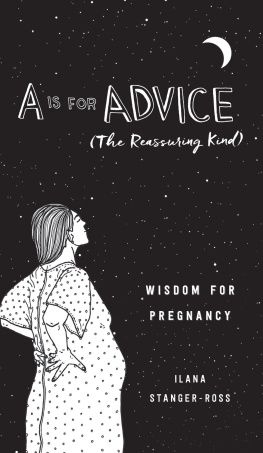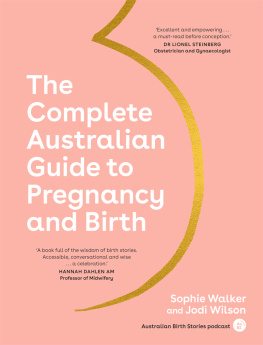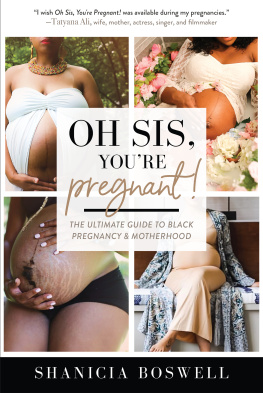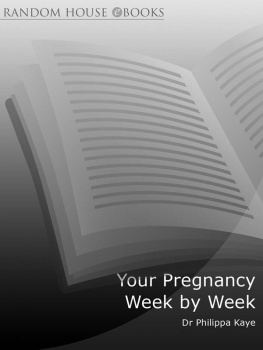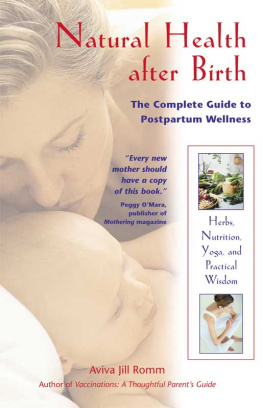For all the families
Ive had the honor to work
with thank you
Contents
T he evening after I shyly shared news of my first pregnancy with my sister-in-law, I came home from work to find a bag of well-worn books on my doorstep. The bag held every bestselling pregnancy advice book, and I sat down eager to consume them all. But as I flipped through the pages, disappointment settled in. A few of the books outlined every potential pregnancy disorder and disaster; others advocated for a particular kind of birth. Eventually I stacked them all in a neat little pile where they sat for the rest of my pregnancy. I didnt want to be told all that could go wrong, or the only way to do things right. I just wanted old-fashioned reassuranceto be told that it would be okay, to be reminded that I wasnt alone.
At the same time as I became a mother, I enrolled in the midwifery program at the University of British Columbia in Vancouver, Canada. In most Canadian provinces, midwifery is fully integrated into the health-care system; in Victoria, British Columbia, where I now practice, midwives attend over 30 percent of deliveries, working alongside our nursing, family physician, obstetrician, and pediatrician colleagues.
Three children, one four-year Canadian midwifery degree, and hundreds of births later, I am writing the stories that I wanted to readand that my clients, through their questions, ask me to tell them.
This book is for anyone who has experienced the transformation of pregnancyin your own body or the body of someone you love. Ive addressed it to first-time parents, but I hope it will speak to you wherever you are in your pregnancy journeythe first time or the fifth, overjoyed, ambivalent, terrified, or all of the above.
While I write from a place of reassurance, I dont mean to advocate complacency. Despite having the costliest maternity care system in the world, the U.S. maternal mortality rate is higher than that of any other developed nation. There are massive racial disparities in health outcomes: African American women are three to four times more likely to die in or after childbirth, even when controlling for income and socioeconomic status. By demanding that pregnancy and childbirth be a journey marked by informed and supportive care providers, this book also represents a call to action.
Every pregnant person deserves to be well cared for in pregnancy, during labor and delivery, and throughout the postpartum period. I hope the stories in this book bring comfort and instill strength for that most important story of all: your own.
There was a time when birth was all around us. It took place nearby, in the home, in the village. There was no need to go hunting for advice manuals to explain what would happenthe knowledge was oral, witnessed, and passed down. Talismans offered protection, ceremonies promised order. The grandmother could help latch the baby, the aunt could demonstrate a swaddle.
This isnt about romanticizing the past or the developing world. Birth is never ordinary. Talismans were there for a reason; nature can be cruel.
We have gained so much. We are so lucky to birth in a time and place where we can access trained care providers, drugs, operating rooms, blood.
And yet: we have lost something too. Most of us will have never seen a birth before giving birth ourselves, and that vacuum fuels our fear. We search for meaningful reassurance at a time when, though childbirth has never been safer, every film and television show depicts birth as an emergency.
Push! the television doctor yells in a scene so well-worn that likely we can all script the rest on cue: the teary-eyed father trying to be brave; the desperate mother saying no, no, I cant do it; the concerned nurse reporting something about oxygen or blood or heart rate patterns; the doctor, even more urgent now, screaming Push! Push!and then, just when all seems lost, the triumphant last red-faced effort, the babys cry, the mothers tears.
And enter the perfectly swaddled six-month-old baby.
(Perhaps the lesson of these television and film depictions of birth really should be: its always dangerous to try to birth a six-month-old.)
Even worse are the stories that so many women share with pregnant friends. When I was pregnant with my first child and introduced to this genre, I dubbed it Tales of Miscarriage and Mayhem. Its not that I advocate silencing those who have had difficult experiences: those stories matter. But as a pregnant woman I heard more she almost died than everything went really well, and I wondered why so many women seemed so set on, well, scaring me.
And then theres the consumerism of modern-day pregnancy: strollers and car seats; cribs, bassinets, and baby wraps; diaper and monitor systems; developmentally appropriate toys and safety locks and... and in this way, one of the most profound passages in a persons life can quickly be reduced to a surprisingly stressful shopping experience.
And yet: pregnancy, birth, those first exhausting weeks of parentingwhat an amazing time-out-of-time. What happens when a woman becomes a mother happens both to her and through her. She is both the traveler and the road traveled and her journey, however it unfolds, will have meaning for her for a lifetime.
Pregnancy advice books generally come with the warning that theyre not meant to replace the advice of a medical professional. To mine I will add: this book isnt meant to replace pregnancy advice books. I wont offer a month-by-month guide to gestation, or a detailed overview of pregnancy disorders. Instead, Ill give the advice that I share with my own midwifery clientsnot the clinical recommendations or informed-choice discussions that I provide on a regular basis, but the advice that creeps into the corners of conversation, the words I say when they ask for more.
Some advice on advice, then: choose carefully what you listen to. And as you travel through the exhaustion and the hassle, the fear and the unpredictability, remember to laugh, and to reflect, and to spend some time just marveling at the wonder of it all.
I promise that I am not about to give you a detailed list of breathing instructions.
But, while there are very few universal truths in labor, heres one: almost every woman panics at some point.
And sometimes a gentle reminder to take a deep breath releases that tension.
As with labor so with everything in life: breathe. Deep, slow, and once again: breathe. Its a clich, sure. But for good reason.
Its not that you can breathe your way to a perfect birth and a perfect baby.
I wish it were that easy, but it isnt.
But you can trick yourself past panic by taking full, deep breaths. Breaths that remind you where you are and what your job is at that moment, whether its remaining at home in the early hours of labor despite an urge to rush to the hospital, or closing your eyes against the glare of the operating room lights as you open yourself to a surgical birth, or knees-bent pushing from a place so deep inside you never knew it existed before.
Or now, as you read this book and wonder, perhaps with excitement or perhaps with trepidation, what your story will be.
Or later, when the baby is crying and your body is sore and you find yourself feeling, maybe, just a little bit lost.

